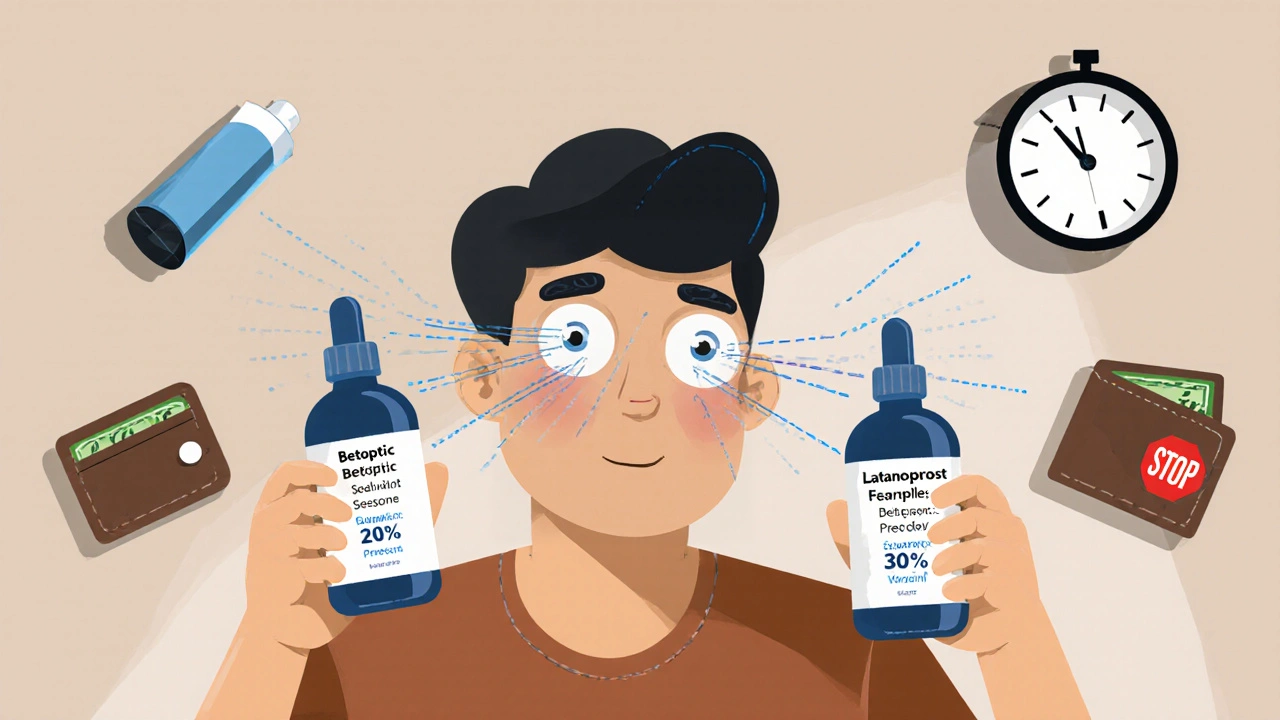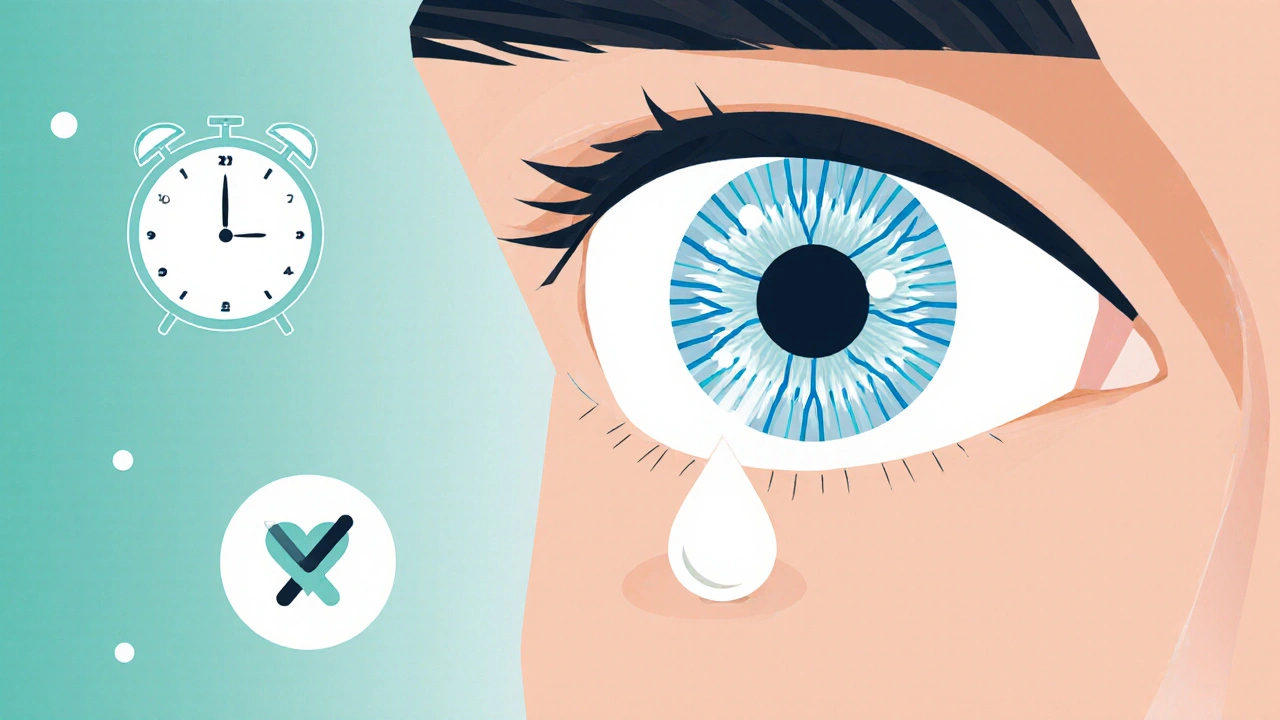If you’ve been prescribed Betoptic (betaxolol) for glaucoma, you’re not alone. Thousands of people use it every day to lower eye pressure and protect their vision. But it’s not the only option. Many patients wonder: Is there something better? Cheaper? Fewer side effects? This guide cuts through the noise and compares Betoptic to other glaucoma treatments you might actually see on your doctor’s prescription pad.
What Betoptic (Betaxolol) Actually Does
Betoptic is a beta-blocker eye drop. Its active ingredient, betaxolol, works by slowing down how much fluid your eye produces. Less fluid = lower pressure inside the eye. That’s critical because high eye pressure is the main driver of optic nerve damage in open-angle glaucoma.
It’s usually applied once a day. That’s one of its biggest perks - easier to remember than drops you need to use three or four times a day. Studies show it lowers eye pressure by about 15-25% in most people. Not the strongest drop out there, but reliable and gentle on the surface of the eye.
It’s often chosen for patients who can’t tolerate other beta-blockers like timolol because betaxolol is more selective. It targets the heart less, which means fewer systemic side effects like slow heartbeat or fatigue. That’s why it’s sometimes picked for people with asthma or mild heart conditions - though your doctor still needs to check your health history first.
Top Alternatives to Betoptic
There are five main classes of glaucoma eye drops. Each works differently. Here’s how Betoptic stacks up against the most common alternatives.
1. Timolol (Timoptic, Betimol)
Timolol is the original beta-blocker eye drop. It’s been around since the 1970s. It lowers eye pressure more than Betoptic - typically by 20-30%. But it’s less selective. That means it can affect your heart and lungs more. People with asthma, COPD, or heart block are usually told to avoid timolol.
It’s also cheaper. Generic timolol costs about $15-$25 for a 5ml bottle in the U.S. Betoptic can run $60-$90 without insurance. If you’re cost-sensitive and don’t have breathing or heart issues, timolol is often the first-line choice.
2. Latanoprost (Xalatan, generic)
This is a prostaglandin analog. Instead of reducing fluid production, it helps your eye drain fluid better. It’s one of the most effective drops on the market - lowering pressure by 25-35%. Many doctors now start with this instead of beta-blockers.
Side effects? It can make your eyelashes grow longer and darker. Your iris might get darker too, especially if you have hazel or green eyes. It’s also applied just once a day. But it can cause eye redness, irritation, or dryness. If you’re okay with those changes, it’s often more effective than Betoptic.
3. Brimonidine (Alphagan P)
Brimonidine is an alpha-2 agonist. It reduces fluid production and increases drainage. It lowers pressure by 20-25%, similar to Betoptic. But it’s not for everyone.
It can cause dry mouth, fatigue, and dizziness - especially in older adults. Some people get allergic reactions: red, itchy eyes. It’s also not recommended for kids under 18 or people on certain antidepressants (MAO inhibitors). Still, it’s a good option if beta-blockers don’t work or cause issues.
4. Dorzolamide (Trusopt)
This is a carbonic anhydrase inhibitor. It works by cutting down how much fluid your eye makes. It’s usually used twice or three times a day, which makes it harder to stick with. It can cause a bitter taste in your mouth, blurry vision, and tingling in your fingers.
It’s often combined with timolol (Cosopt) to boost effectiveness. Alone, it’s not as strong as prostaglandins or even Betoptic. But if you need a combo and can’t use beta-blockers, dorzolamide is a solid backup.
5. Combigan (Brimonidine + Timolol)
This is a combo drop - two medications in one bottle. It’s used when one drop isn’t enough. It lowers pressure more than either drug alone, often by 30% or more. But you’re getting all the side effects of both: dry eyes, fatigue, dizziness, and possible heart effects from timolol.
It’s expensive. A 2.5ml bottle can cost over $150 without insurance. But if your pressure is still too high on Betoptic alone, this might be the next step.
Side Effects Comparison
Not all drops are created equal when it comes to how they make you feel. Here’s a quick breakdown of the most common side effects.
| Medication | Eye Irritation | Systemic Side Effects | Long-Term Changes |
|---|---|---|---|
| Betoptic (Betaxolol) | Mild (burning, stinging) | Low risk - rare slow heart rate | None |
| Timolol | Moderate | Higher risk - fatigue, low BP, asthma flare-ups | None |
| Latanoprost | Common - redness, itching | Very low | Darker iris, longer lashes |
| Brimonidine | Common - redness, allergy | High - dizziness, dry mouth, depression risk | None |
| Dorzolamide | Moderate | Moderate - metallic taste, tingling | None |
| Combigan | High - combines both | High - combines both | None |
If you have asthma, heart disease, or depression, this table matters. Betoptic is safer than timolol or brimonidine for heart and lung issues. But if you’re young and healthy, latanoprost might give you better pressure control with fewer systemic risks.
Cost and Insurance Coverage
Price is a huge factor. In Australia, PBS-subsidized options like timolol cost under $7 per bottle. Betoptic is not on the PBS list, so you’ll pay full price - around $80-$100 without a subsidy. Latanoprost is also not subsidized unless you meet specific criteria (like advanced glaucoma), so it can run $90-$120.
Combigan is the most expensive - often over $150. Generic versions of timolol and dorzolamide are your best bets if cost is tight. Many patients start with timolol, then switch to latanoprost if pressure isn’t low enough. Betoptic usually comes in when timolol isn’t safe.
Who Should Use Betoptic? Who Should Avoid It?
Betoptic is a good fit if:
- You have mild to moderate glaucoma and need once-daily dosing
- You have asthma, COPD, or a slow heart rate and can’t take timolol
- You’re older and want fewer systemic side effects
- You’ve tried latanoprost and had too much eye redness or lash growth
Avoid Betoptic if:
- Your eye pressure is very high and you need maximum reduction
- You’re on other beta-blockers (oral or IV) - risk of additive effects
- You have severe heart failure or very low blood pressure
- You’re allergic to any beta-blocker
It’s not a first-choice drug anymore in many clinics. But it’s still a valuable tool - especially when safety matters more than peak effectiveness.

What Doctors Actually Recommend
In Melbourne and other major cities, glaucoma specialists usually follow this pattern:
- Start with a prostaglandin analog (latanoprost, travoprost, tafluprost) - highest efficacy, once daily, few systemic side effects.
- If that doesn’t work or causes too much redness, switch to a beta-blocker - but pick betaxolol over timolol if there’s any heart or lung concern.
- If pressure is still too high, add a second drop - often dorzolamide or brimonidine.
- Only consider combination drops like Combigan if you’re struggling to stick with multiple bottles.
Betoptic doesn’t lead the pack in effectiveness, but it’s a smart middle ground. It’s not the strongest, but it’s one of the safest beta-blockers. For many patients, that balance is exactly what they need.
What to Do If Betoptic Isn’t Working
If your eye pressure hasn’t dropped enough after 4-6 weeks, don’t wait. Talk to your eye doctor. High pressure can silently damage your vision. Options include:
- Switching to latanoprost or travoprost
- Adding dorzolamide or brimonidine
- Trying a laser procedure (SLT) - quick, painless, and often covered by insurance
- Considering surgery if other treatments fail
Don’t just keep using a drop that’s not working. Glaucoma is a slow-moving disease - but it doesn’t wait forever.
Final Thoughts
Betoptic isn’t the most powerful glaucoma drop. But it’s one of the safest for people with heart or lung conditions. If you’re on it and feeling fine, there’s no reason to switch. But if your pressure is still too high, or you’re paying too much, ask your doctor about alternatives.
There’s no one-size-fits-all solution. What works for your neighbor might not work for you. Your eye pressure, your health history, your budget - they all matter. The goal isn’t to find the ‘best’ drop. It’s to find the right one for you.
Is Betoptic better than timolol for glaucoma?
Betoptic is safer for people with asthma, COPD, or heart rhythm issues because it’s more selective. But timolol lowers eye pressure more effectively. If you don’t have heart or lung problems, timolol is often preferred as a first choice because it’s cheaper and stronger.
Can Betoptic cause blindness?
No, Betoptic doesn’t cause blindness. In fact, it helps prevent it by lowering eye pressure. The real risk comes from not treating glaucoma at all. If Betoptic isn’t lowering your pressure enough, your vision could be at risk - not because of the medicine, but because the disease is progressing.
How long does it take for Betoptic to work?
You’ll usually see a drop in eye pressure within 1-2 hours after the first dose. But it takes about 2-4 weeks for the full effect to show. Your doctor will check your pressure after 4-6 weeks to decide if it’s working well enough.
Can I use Betoptic with other eye drops?
Yes, but wait at least 5-10 minutes between drops. Putting them in too close together means the second drop washes out the first. Many people use Betoptic with latanoprost or dorzolamide if one drop isn’t enough.
Is there a generic version of Betoptic?
Yes, generic betaxolol is available in many countries, including the U.S. and Canada. But in Australia, it’s not subsidized on the PBS, so it’s still expensive. Always check with your pharmacist - sometimes the generic is priced similarly to the brand.
What happens if I miss a dose of Betoptic?
If you miss a dose, apply it as soon as you remember. But if it’s almost time for your next dose, skip the missed one. Don’t double up. Missing one dose won’t hurt, but regularly skipping doses lets eye pressure rise - which increases glaucoma risk.


Tim H
betoptic is okay i guess but timolol is way cheaper and works better unless you got asthma or something. i was on it for a year and my pressure dropped like 30% no joke. my doc tried to push me to betoptic cause i had a little heart thing but i was like nah i can handle the side effects.